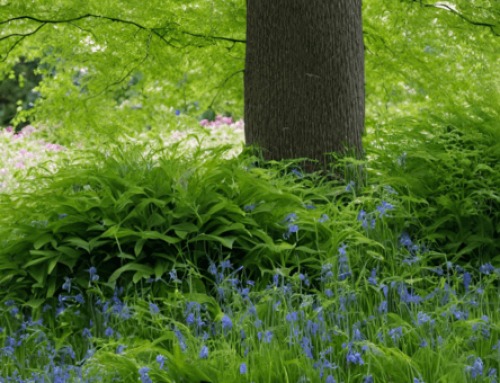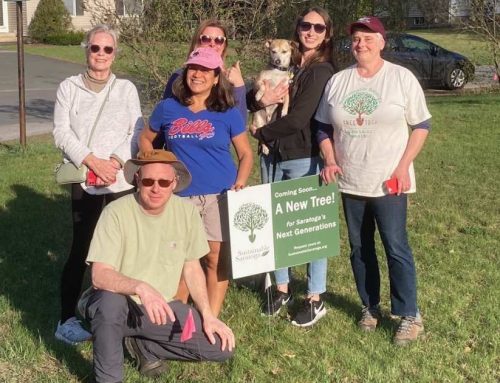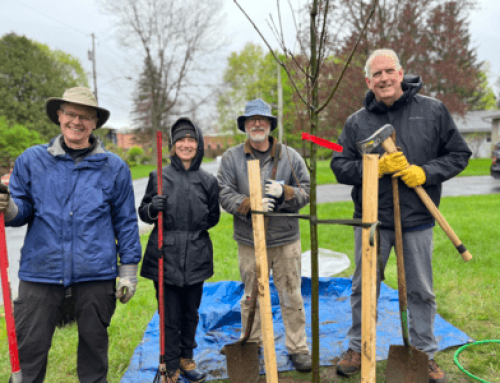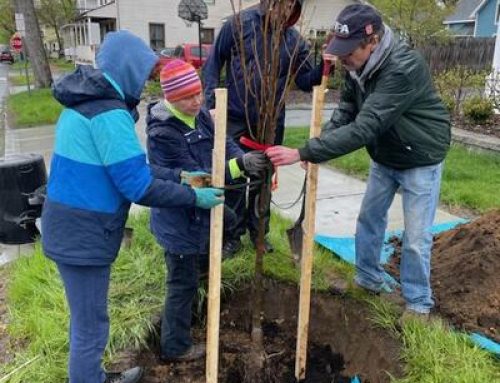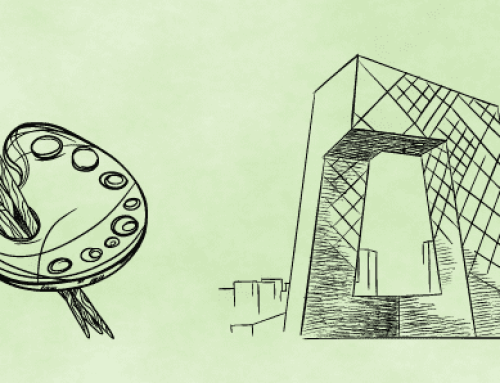
In honor of Women’s History Month, we want to highlight just a handful of the influential, brave, groundbreaking women who have had a positive impact on our planet and our lives. Women are powerful voices for change and we hope to inspire you with some of these stories.
Wangari Muta Maathai

Sustainable Saratoga Board member, Anne Ernst, recommended we profile Wangari for our trailblazing women series.
Wangari Muta Maathai was a fearless, rabble-rousing environmentalist and feminist who advocated for the rights of those who had the least power. One of 300 Kenyans chosen to go to a US university through the Kennedy Airlift program, she got her BS and MS in the US, then became the first East African woman to earn a Ph.D. from the University College of Nairobi. She was the first female professor at the University of Nairobi and organized a union to negotiate equal benefits for women. She believed that the hardships of the rural poor (environmental degradation, deforestation, food insecurity) were caused by disempowerment and loss of traditional community values, and she fought for a great democratic space, particularly for women.
Dr. Maathai founded the Greenbelt Movement, which focused on desertification, deforestation, water crises, and rural hunger. She paid women to gather seeds from native trees and successfully rear them to seedlings, and then planted those seedlings across Kenya. In the immediate focus, this addressed the concerns of rural Kenyan woman who said that, because local streams were drying up, they had to walk a long distance for firewood and their food supply was not secure. In the longer-term focus, the Greenbelt Movement began running seminars for women in civic and environmental education, to advocate for greater democratic space and to demand more accountability from national leaders.
Dr. Maathai fought a long series of conflicts against Kenyan president Daniel Moi, who cut off funding to the Greenbelt Movement and had Maathai thrown in jail multiple times. She was elected to Parliament in 2002, the same year that Moi lost power. She won the Nobel Peace Prize in 2004 for her effort to promote sharing resources in an equitable way. She passed away in 2011 from ovarian cancer, and the world is all the poorer for her loss.
Photo credit: Kingkongphoto & www.celebrity-photos.com from Laurel Maryland, USA – Wangari Maathai 2004 Nobel Peace prize winner, CC BY-SA 2.0, https://commons.wikimedia.org/w/index.php?curid=75053665
 Anne LaBastille
Anne LaBastille
Our Board member and co-chair, Dianna Goodwin, recommended Anne LaBastille for our list of trailblazing women. Anne LaBastille was a conservationist and writer who lived and wrote in a cabin in the Adirondacks, à la Thoreau. You may be familiar with her best-known work, a four-part book series titled Woodswoman. She was one of the early conservationists that gave attention to important issues like acid rain and climate change. She was a staunch conservationist, a charter member of the New York State Adirondack Guides Association, and a commissioner of the Adirondack Park Agency. She was also a feminist, a photographer, a Cornell faculty member.
Her obituary in the Adirondack Explorer described Anne: “To outsiders, her life seemed austere and simple, but she was a bundle of contradictions: tough yet tender, naïve yet calculating, and repulsed yet attracted by the power of her celebrity. She spoke in a near-whisper, allowing her writing to do the shouting. She had few peers when it came to stubbornness. Still, she was admired for steadfastly fighting for the preservation of the natural world. Her appeal was broad and lasting, yet her footprint on the earth was light and fleeting. She found all the philosophy she needed in the still, crystalline waters of a mountain lake at dawn.”
She has a fascinating life story, which is too hard to capture in this short space, so please check out these two links to learn more:
Mary Oliver
 One of our Board members, Robin Ambrosino, recommended Pulitzer Prize winning poet Mary Oliver for our list. Robin: “I’m not a big fan of poetry in general. But Mary Oliver’s poems about the natural world appeal to me. They’re written in language I can understand.” They’re not “fancy” – as Mary Oliver herself said about her work. Mary had a deep love of nature, which is illustrated by these lines from “When Death Comes”
One of our Board members, Robin Ambrosino, recommended Pulitzer Prize winning poet Mary Oliver for our list. Robin: “I’m not a big fan of poetry in general. But Mary Oliver’s poems about the natural world appeal to me. They’re written in language I can understand.” They’re not “fancy” – as Mary Oliver herself said about her work. Mary had a deep love of nature, which is illustrated by these lines from “When Death Comes”
When it’s over, I want to say: all my life
I was a bride married to amazement.
I was the bridegroom, taking the world into my arms.
Mary Oliver died in 2019, but her voice lives on. Here’s her obituary from The Guardian. And here are a few of Robin’s favorite poems:
North Country
When I Am Among the Trees
This World
You can read more about Mary Oliver from the Poetry Foundation.
Photo credit: PoetryFoundation.org
Eunice Foote
Board member, Laura Faulk, nominated climate pioneer, Eunice Foote, for this series.

More than 150 years ago, Eunice Foote performed a simple but elegant experiment that led to a remarkable conclusion – that greenhouse gases warm the planet. Her experiment entailed filling glass cylinders with various substances like carbon dioxide and water vapor, placing them in the sun, and then recording the air temperatures inside. She noted that moist air became warmer than dry air, and that carbon dioxide caused the temperature to rise even more. She concluded, “An atmosphere of [carbon dioxide] would give to our earth a high temperature; and if as some suppose, at one period of its history the air had mixed with it a larger proportion than at present, an increased temperature…must have necessarily resulted.” Foote’s work did not garner the attention it warranted, in part due to her gender. Foote was also a feminist and a signer of the Declaration of Sentiments at the first Woman’s Rights Convention in Seneca Falls in 1848. She also has another New York connection: She attended the Troy Female Seminary from 1836-1838.
You can learn more about Eunice here:
- Happy 200th birthday to Eunice Foote, hidden climate science pioneer!
- Overlooked no more: Eunice Foote, climate scientist lost to history
- This Suffrage-Supporting Scientist Defined the Greenhouse Effect But Didn’t Get the Credit, Because Sexism
Image Credit: Drawing by Carlyn Iverson, NOAA Climate.gov
Julia Butterfly Hill
 Board member and co-chair, Laura Rappaport, recommended we profile Julia Butterfly Hill. Many of you may remember media coverage of her 738-day sit-in up in the branches of a 1,000-year-old California redwood tree in the late 1990s. Her courageous act of civil disobedience brought world-wide attention to the environmental impacts of clear cutting and the importance of preserving these unique ancient forests. Since climbing out of that tree, Julia has been a motivational speaker on social and environmental activism, an author, and a life coach. You can read more about what she’s been working on these days on her website.
Board member and co-chair, Laura Rappaport, recommended we profile Julia Butterfly Hill. Many of you may remember media coverage of her 738-day sit-in up in the branches of a 1,000-year-old California redwood tree in the late 1990s. Her courageous act of civil disobedience brought world-wide attention to the environmental impacts of clear cutting and the importance of preserving these unique ancient forests. Since climbing out of that tree, Julia has been a motivational speaker on social and environmental activism, an author, and a life coach. You can read more about what she’s been working on these days on her website.
Learn more about Julia:
Lois Gibbs
 Board member and co-chair, Dianna Goodwin, suggested we highlight activist Lois Gibbs, “The Mother of Superfund” and organizer of the Love Canal fight. Lois had no formal training, but armed with persistence and passion, she founded the Love Canal Homeowner’s Association and fought government bureaucracy and industry money to protect the health of her Niagara Falls community. After years of struggle, more than 800 families were evacuated, and cleanup of Love Canal began. Her efforts also led to the creation of the Environmental Protection Agency’s Superfund program. Gibbs inspired many people with her story about the power of ordinary citizens to enact meaningful change on environmental and social issues. She continues to be active on environmental justice issues, and formed the Center for Health, Environment and Justice to help train and support community groups around the country.
Board member and co-chair, Dianna Goodwin, suggested we highlight activist Lois Gibbs, “The Mother of Superfund” and organizer of the Love Canal fight. Lois had no formal training, but armed with persistence and passion, she founded the Love Canal Homeowner’s Association and fought government bureaucracy and industry money to protect the health of her Niagara Falls community. After years of struggle, more than 800 families were evacuated, and cleanup of Love Canal began. Her efforts also led to the creation of the Environmental Protection Agency’s Superfund program. Gibbs inspired many people with her story about the power of ordinary citizens to enact meaningful change on environmental and social issues. She continues to be active on environmental justice issues, and formed the Center for Health, Environment and Justice to help train and support community groups around the country.
Learn more about Lois:
- Love Canal – Center for Health, Environment & Justice
- Lois Gibbs – Goldman Environmental Foundation
- Lois Gibbs: Grassroots Organizer and Environmental Health Advocate
Photo Credit: www.chej.org
Winona LaDuke
 Winona LaDuke is a charismatic leader and grassroots organizer on climate change, Indigenous rights, environmental and human rights issues. A member of the Ojibwe Tribe, a graduate of Harvard and Antioch universities, a mother, an activist, and a political and cultural leader – LaDuke has become a leading voice in the struggle to protect Indigenous culture, food and lands. She is the Executive Director of Honor the Earth, which works to raise awareness and support for Native environmental issues. She was highly visible among the opposition movement for the Keystone pipeline. She was also presidential hopeful Ralph Nader’s running mate in 1996 and 2000. In 2007, LaDuke was inducted into the National Women’s Hall of Fame for her leadership and impact.
Winona LaDuke is a charismatic leader and grassroots organizer on climate change, Indigenous rights, environmental and human rights issues. A member of the Ojibwe Tribe, a graduate of Harvard and Antioch universities, a mother, an activist, and a political and cultural leader – LaDuke has become a leading voice in the struggle to protect Indigenous culture, food and lands. She is the Executive Director of Honor the Earth, which works to raise awareness and support for Native environmental issues. She was highly visible among the opposition movement for the Keystone pipeline. She was also presidential hopeful Ralph Nader’s running mate in 1996 and 2000. In 2007, LaDuke was inducted into the National Women’s Hall of Fame for her leadership and impact.
Learn more here:
Photo credit: honorearth.org
Margorie (Margie) Richard
 Our Executive Director, Wendy Mahaney, recommended Marjorie Richards for this series. Marjorie (Margie) Richard has spent decades fighting environmental racism, starting in her own backyard. Margie grew up in the historically Black Old Diamond neighborhood in Norco, Louisiana. You might be more familiar with its other name, Cancer Alley. Richard fought to hold corporations accountable for the health impacts caused by their pollution. In Norco, Margie fought Shell for over 25 years before the residents of Old Diamond were relocated and the Shell agreed to reduce its toxic emissions by 30%. Her work in Norco and her dedication to helping other communities fight corporate pollution earned her the Goldman Environmental Prize in 2004. She was the first Black recipient of this award.
Our Executive Director, Wendy Mahaney, recommended Marjorie Richards for this series. Marjorie (Margie) Richard has spent decades fighting environmental racism, starting in her own backyard. Margie grew up in the historically Black Old Diamond neighborhood in Norco, Louisiana. You might be more familiar with its other name, Cancer Alley. Richard fought to hold corporations accountable for the health impacts caused by their pollution. In Norco, Margie fought Shell for over 25 years before the residents of Old Diamond were relocated and the Shell agreed to reduce its toxic emissions by 30%. Her work in Norco and her dedication to helping other communities fight corporate pollution earned her the Goldman Environmental Prize in 2004. She was the first Black recipient of this award.
You can find more about her fascinating story at:
- Goldman Environmental Prize
- Here is a great interview with Margie: How one woman fought one of the world’s biggest oil companies — and won
- Margorie (Margie) Richard

